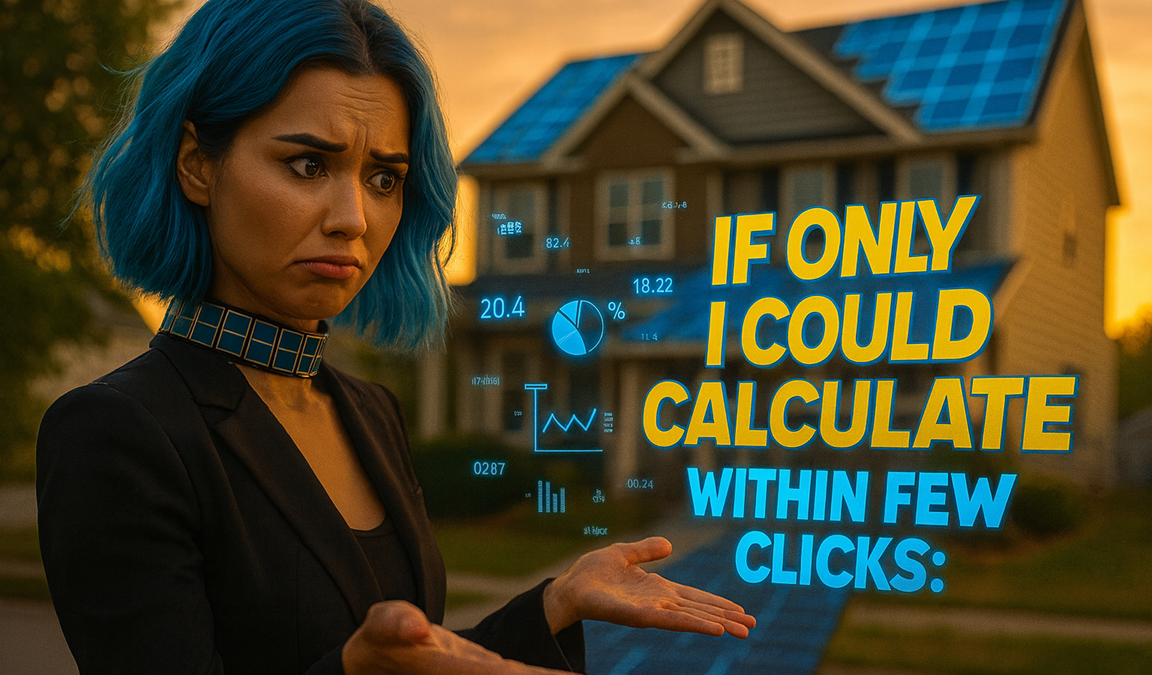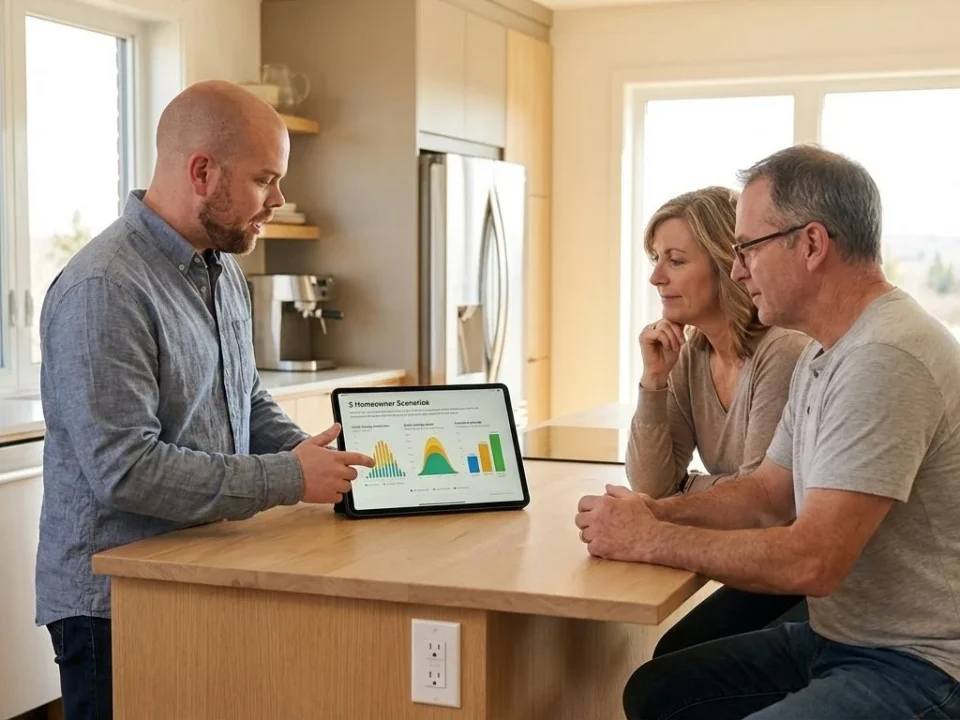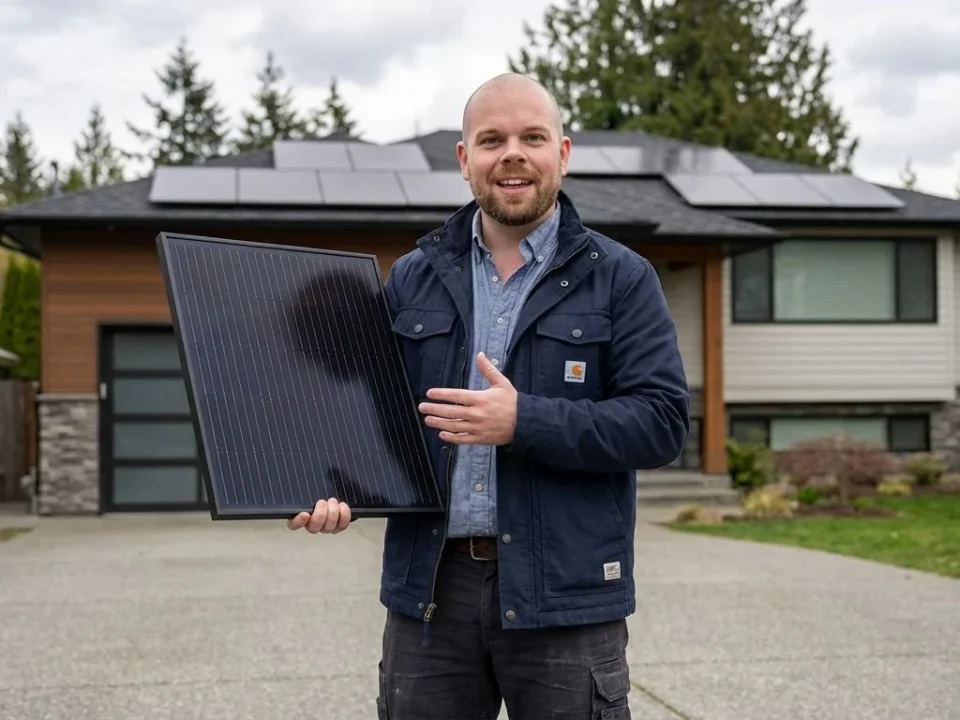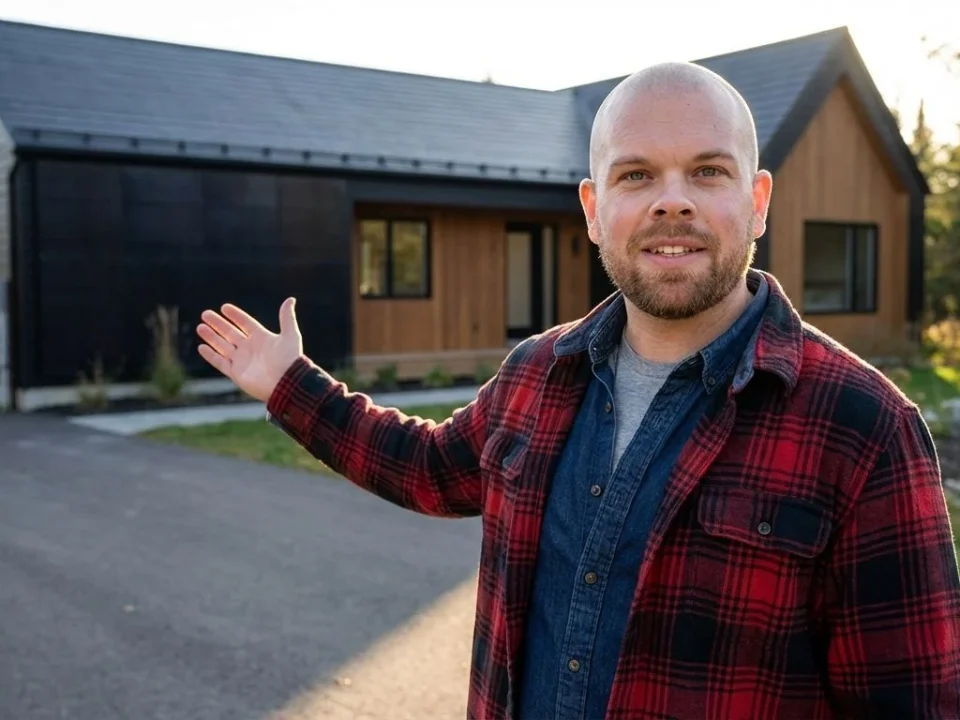
Balcony Solar Panels: Which Type To Choose And How to Use it in Canada?
August 19, 2025
Alberta Jails Go Solar: The Shocking Plan to Save Taxpayers Millions
August 21, 2025Figuring out the price of a complete solar system for your home isn’t about finding a magic number online. Many calculators give you a ballpark figure, but the real, accurate price comes from understanding the specific data points about your home and energy use. I’m Vitaliy Lano, and after 12 years in home improvement and sustainability, I’ve seen too many people get sticker shock because they started with a vague estimate. My goal with SolarEnergies.ca is to show you how the calculations are really done, so you can be in control of your investment. Canada goes solar, and it’s my job to make sure you do it the smart way.
Try Our Solar Panels Calculator
This isn’t about guesswork. It’s about data. Let’s break down what truly goes into the cost of a home solar system in Canada.
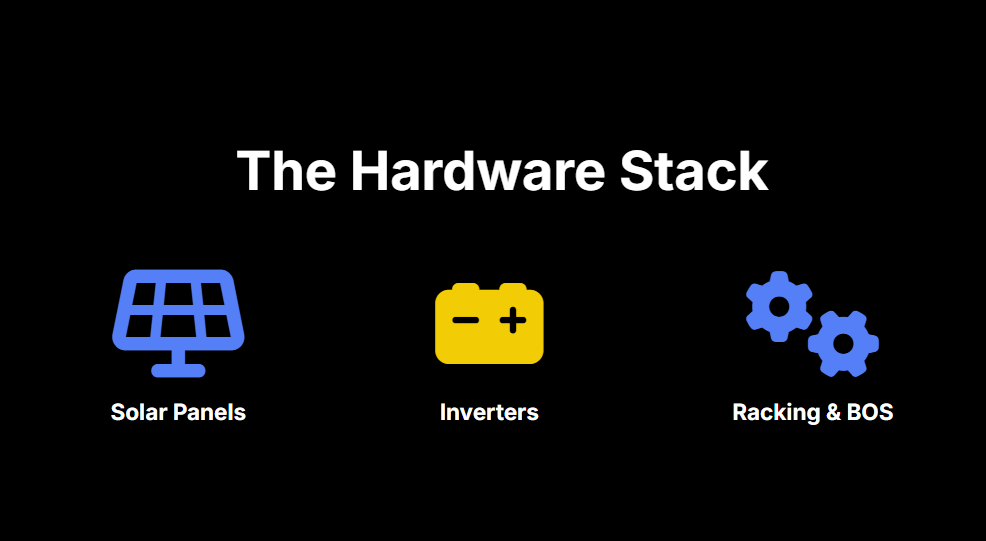
What Solar Panel Costs Are Involved in Building a Home Solar System?
When you get a quote for a residential solar system, it’s more than just the solar panel costs. The total price is a sum of several parts, each important for a safe and efficient power system.
Understanding Initial Solar Panel Costs
The panels themselves are a significant part of the budget. The cost of solar panels can vary widely based on the technology. For instance, monocrystalline solar panels are more efficient and come with a higher price tag than polycrystalline panels. You might see prices ranging from $2.40 to $3.50 per watt for the entire system, depending on your province and the equipment you choose. For a typical 7-kilowatt (kW) system, the total cost could be anywhere from $17,500 to $24,500 before any incentives.
Here’s a quick look at how panel type can influence cost and efficiency:
| Panel Type | Average Cost per Watt (Panel Only) | Efficiency | Key Feature |
|---|---|---|---|
| Monocrystalline | $0.80 – $1.20 | 17-22% | High efficiency, sleek black look. |
| Polycrystalline | $0.60 – $0.90 | 15-17% | Lower cost, slightly less efficient. |
| Bifacial | $0.90 – $1.40 | 20-22% | Captures light from both sides. |
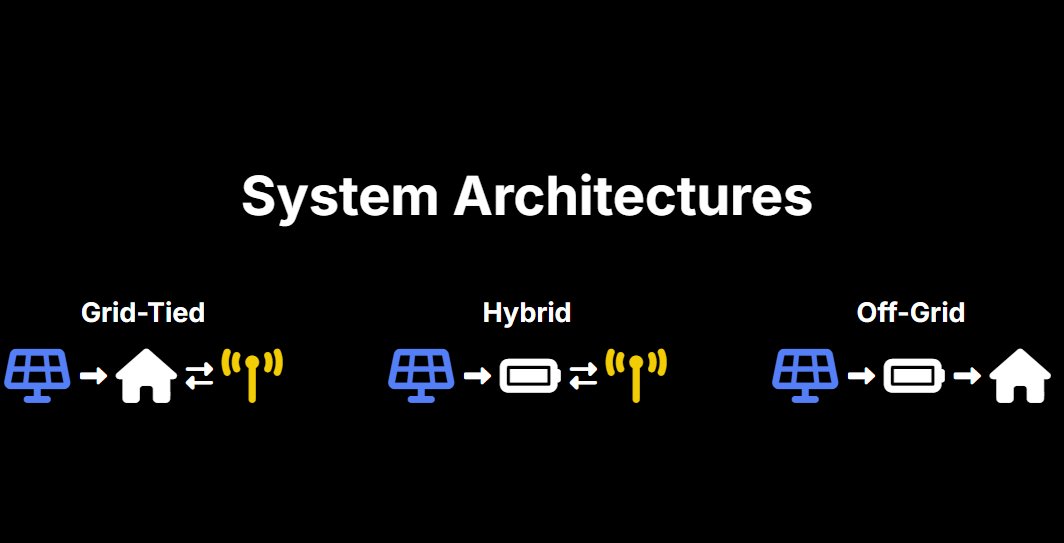
Factoring in Solar Installation Expenses
Solar installation costs are a big piece of the puzzle. This isn’t just labour. It includes racking to mount the panels, wiring, and the solar inverter, which converts the DC power from your panels to the AC power your home uses. Permitting and inspection fees also fall into this category. A professional solar installer handles all of this, ensuring the system is up to code and safe. For a standard 10kw solar system, installation and associated components can make up 30-40% of the total price.
Considering Long-Term Solar Energy Savings
The initial cost is just one side of the coin. The other is your savings on power bills. A properly sized solar power system can offset a huge portion of your electricity usage. In provinces with high electricity rates, the payback period can be as short as 8-12 years. After that, the solar energy you generate is essentially free. Plus, installing a solar panel system can increase your home value.
What Size Solar Power System Do I Need to Power My Home?
This is the most critical data point for an accurate price. A system that’s too small won’t meet your needs, and one that’s too large is a wasted investment.
Estimating Your Solar Power Consumption
Your electricity bill is the source of truth here. Look for your annual kilowatt-hour (kWh) consumption. If you can’t find an annual number, gather your last 12 monthly bills and add up the kWh usage. An average Canadian home uses around 11,000 kWh per year, but this varies wildly based on your lifestyle, heating sources, and province.
Tip for Accuracy: Don’t just guess your usage. Pull out the actual bills. This single piece of data has the biggest impact on your system size and cost of your solar project.
Calculating the Number of Solar Panels Needed
Once you know your annual usage, you can estimate the system size. The formula is straightforward:
System Size (kW) = Annual kWh Usage / (Average Peak Sun Hours per Year x 0.85)
The “0.85” accounts for system inefficiencies. Peak sun hours vary by location. Calgary might get over 1,400 hours a year, while Toronto gets closer to 1,200.
Let’s say you use 10,000 kWh a year and live in an area with 1,300 peak sun hours:
10,000 kWh / (1,300 hours * 0.85) = 9.0 kW
You’d need approximately a 9.0 kW system. If you use 420w solar panels, you would need around 22 of them (9000 / 420 = 21.4).

Choosing the Right Solar Inverter
The inverter needs to be sized to handle the output of your solar array. There are a few main types:
- String Inverters: A single inverter connects a series of panels. Cost-effective but can be affected by shading on a single panel.
- Microinverters: One small inverter is attached to each panel. More efficient, especially if you have some shading, but more expensive.
- Hybrid Inverter: A hybrid inverter can manage power from your panels, the grid, and a solar battery. This is what you need for a hybrid solar system with backup power. The Sol-Ark 15k is a popular 15k hybrid inverter option for homeowners wanting energy independence.
Which Type of Solar Kit is Best for My Home?
A solar kit bundles the main components together. The right panel kit for you depends on your connection to the utility grid.
Comparing Grid-Tie Systems
A grid-tie system is the most common residential solar setup in Canada. Your home draws power from the solar panels when the sun is shining. If you produce more solar power than you need, it gets sent to the grid, and you get a credit through net metering. When you need more power than your panels are producing (like at night), you draw from the grid. A grid-tie solar kit is the most affordable option.
Understanding Off-Grid Solar Systems
A complete off-grid solar system is not connected to the utility grid at all. This requires a much larger solar array and a significant solar battery bank, often using lithium batteries like LiFePO4 for their longevity. These systems are for remote properties where grid connection is impossible or prohibitively expensive. An off-grid solar kit will include panels, a charge controller, a battery and inverter, and often a generator for backup.
Exploring Hybrid Solar Systems with Solar Battery Backup
A hybrid solar system gives you the best of both worlds. It’s connected to the grid like a grid-tie system, but it also includes a solar battery. This allows you to store excess solar energy to use during power outages or at night, giving you energy independence. This is becoming a popular option for homeowners who want backup power without going fully off-grid.
What Are the Benefits of a Complete Solar Panel Kit?
Buying a complete solar kit can simplify the process of adding solar to your home.
Convenience and Cost-Effectiveness of Complete Solar Kits
A kit complete with all necessary components often comes at a better price than sourcing each part individually. Companies that sell solar panel kits have done the work of matching components for you.
Ensuring Compatibility with Power System Components
When you buy a complete solar power kit, you know the inverter is correctly sized for the panels, and the racking is compatible. This removes the guesswork and potential for costly mistakes. Whether it’s a small 12v solar kit for an RV or a large 14.4kw solar system for a home, compatibility is key.
Streamlining Solar Installation with a Comprehensive Panel Kit
For the solar installer, a complete solar panel kit makes the solar panel installation process smoother and faster. All the parts are there, designed to work together. This can reduce labour costs, which in turn can reduce the cost of the overall project for you.
How Does a Solar Inverter Work and Why is it Important?
The solar inverter is the brain of your solar system. Without it, the power generated by your panels is unusable in your home.
Understanding Solar Inverter Functionality
Solar panels produce Direct Current (DC) electricity. Your home and the electrical grid use Alternating Current (AC) electricity. The inverter’s job is to make that conversion. A pure sine wave inverter produces clean, high-quality power that is safe for all your electronics.
Choosing the Right Solar Inverter Size and Type
The inverter’s capacity (measured in watts) should be close to the total wattage of your solar array. As mentioned, you can choose between string inverters, microinverters, or a hybrid inverter. For larger systems, you might see options like a 12k hybrid inverter or the Sol-Ark 15k.
Maximizing Solar Power Output with Efficient Inverters
A high-efficiency inverter will convert more of the DC electricity from your panels into usable AC power. Even a 1-2% difference in efficiency adds up to significant energy savings over the 25+ year lifespan of your solar panel system.
Can I Install a Solar System Myself, or Should I Hire a Professional?
I get this question a lot. While a small rv solar setup can be a DIY project, a full home solar system is a different story.
Evaluating Your DIY Solar Installation Skills
Installing a residential solar system involves high-voltage electrical work and working at heights. It requires a deep understanding of electrical codes and safety procedures. It’s not a weekend project for the average homeowner.
Weighing the Pros and Cons of Professional Solar Installation
Pros of Professional Installation:
- Safety: Licensed electricians and experienced installers ensure the system is safe.
- Warranty: Professional installation protects your equipment warranties. A DIY install can void them.
- Efficiency: A pro will design the system for optimal power generation.
- Incentives: You cannot claim most solar incentives without installation by a licensed professional.
Cons:
- Cost: Labour is a significant part of the average cost.
I once had a client who tried a DIY installation to save money. He ended up wiring the inverter incorrectly, damaging a $3,000 piece of equipment. The cost to hire an electrician to fix the mess and properly install the system was more than if he’d just hired a professional solar installer from the start.
Understanding Solar Incentives and Regulations
Provinces and municipalities across Canada have different rules and solar incentives. A professional installer is up-to-date on these. The main federal program is the Canada Greener Homes Loan, which is an interest-free loan to help finance your project.
Important Disclaimer: The popular Canada Greener Homes Grant (which offered up to $5,000) is no longer accepting new applicants as of early 2024. If you see websites still promoting it as available, that information is outdated. The interest-free Loan is still active, but the grant portion of the program is closed to anyone not already in the application process.
Getting an accurate price for a complete solar system for your home isn’t about a quick online search. It’s about gathering the right data: your annual energy consumption, your location, the type of system you want, and the specific components you choose. By understanding these factors, you can have an intelligent conversation with a solar installer and get a quote that reflects the true cost of your solar investment. You can then make an informed decision and take control of your energy future.

